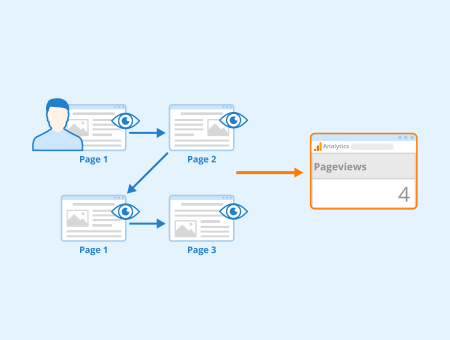Definition

Pageviews (abbreviated PV) is an online marketing term that refers to the display of a single page or ad and has become a key figure in evaluating online products. PVs do not require any user action and are not assigned to unique visitors. That means one visitor can call up multiple pages during the same visit and thus leave several pageviews.
Since pageviews cannot provide you with clear information about specific user behavior, they are primarily a quantitative analysis method. To perform a qualitative analysis and gather more details about user behavior, you need additional metrics.
Measuring pageviews in online marketing
When users access your website, the webserver transfers the respective HTML file to the visitors’ browser. As soon as the page is called up, the visit is recorded as a pageview in the log file of the responsible server. This works the same way for every individual page, thus each access counts as a pageview. Note that not only visitors can generate pageviews, but also automated calls. As a result, search engine crawlers and human visitors generate pageviews, which can only be distinguished after a precise analysis of the visitor sources (IP addresses and hostnames).
Difference to “visits” and “unique visitors”
Online marketing uses the term “visits” to describe how many users access your web pages. In this context, it does not matter if a visitor calls up a single page or several of them, it always counts as one visit. This visit ends if the visitor stays inactive for more than 30 minutes. Inactive means they do not perform any further action (like clicking on a link) or leave the website. Page visits are counted individually, thus, a single visitor that calls up your web page two times a day generates two visits. The number of visits is considered in relation to a certain period of time, such as day, week, or month. This metric is very important to perform detailed analysis because you can obtain valuable information on navigation (landing page) and other important factors such as the dwell time of visitors or bounce rate through this key figure.
While a single visitor can generate multiple page views and visits, they will always count as one unique visitor. These unique visitors are tracked using cookies which is a small text file that is stored in your visitors’ browser when they access your web page. Cookies contain an anonymous ID that can be used to uniquely identify a browser. If a user accesses your website several times within one day, they are recognized as a unique visitor based on this unique ID and registered only once. However, there can be some inaccuracies when measuring unique visitors. For example, it is possible that a web browser does not accept cookies or that a user intentionally deletes them.
Importance for online marketing
Pageviews are very important for online marketing. The number of pageviews allows you to estimate how relevant a site is for advertising purposes. A website with a lot of PVs means that your display advertising has a high reach. Furthermore, pageviews influence the pricing of online ads. Display advertising is often billed using the cost per thousand (CPM) model, where the advertiser pays an agreed price per one thousand views of their ad or pageviews, also called ad views in this context. However, you should keep in mind that ads can be placed more than once on a single web page, thus generating several ad views per pageview.
Benefits for search engine optimization (SEO)
Pageviews can show you which of your pages are visited frequently. However, this number is no decisive factor to draw conclusions about the quality of a page when it comes to SEO. The fact that a web page is frequently accessed does not mean that it offers users what they expect. In order to get valuable information about your pages’ content, you have to combine pageviews with other key figures like bounce rates and dwell times. In order to avoid distorting the results, you should exclude web crawlers and automated retrievals from your analysis.
Related links
Similar articles
